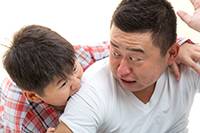Somewhere between 2 and 12 months (or later), your baby’s teeth will make their grand, grumpy entrance. Here’s how to read the symptoms of teething along with remedies to ease baby’s discomfort.
When your baby’s first tooth shows up, you might be taken by surprise (“Ow! Was that just a bite?”), or you might just finally understand what all those surefire teething signs — drooling, night waking, crabbiness — were pointing to. Every baby experiences teething differently: Some have virtually no symptoms, while other babies experience teething pain for months. Fortunately, there are some signs to watch for as this developmental milestone approaches that can help make teething easier for your baby — and for you.
When Do Babies Start Teething?
Most babies grow their first tooth around 7 months old, although there’s a wide variation in timing of teething. For example, some babies grow their first tooth as early as two or three months whereas others don’t get one until after their first birthday. Teething symptoms, however, can precede the actual appearance of a tooth by as much as two or three months.
In What Order Do Teeth Appear?
The most common first teeth are the two in the bottom center, followed by the two in the top center. Then, the pattern goes outward with lateral incisors, which are in the next spot over, followed by the first molars, or the molars closest to the opening of baby’s mouth. Then come the canines on either side of the lateral incisors and last are the second molars in the very back. See the American Dental Association’s tooth eruption chart.
9 Common Teething Symptoms
Your little one is not likely to understand why he feels so achy, why he keeps waking up in the night with soreness in his mouth or why his chin is so itchy. So here are top teething symptoms to keep an eye out for:
- Drooling. It’s hard to believe so much fluid can come from the mouths of tiny babes, but teething stimulates drooling, and the waterworks are on for many babies starting from about 10 weeks to three or four months of age. If you find that your baby’s shirts are constantly soggy, fasten on a bib to keep her more comfortable (and cleaner), and gently wipe her chin throughout the day to stave off chapping.
- Teething rash. If your teething baby is pouring out prodigious amounts of drool, the constant drip may cause chafing, chapping, redness and rashes around her mouth and chin (and even on her neck). Patting away the drool will help prevent the rash. You can also create a moisture barrier with Vaseline or Aquaphor, and moisturize with a gentle unscented skin cream as needed. Have some nipple cream (like Lansinoh) on hand? It’s great for protecting tender baby skin, too.
- Coughing and/or gag reflex. All that drool can make babies gag and cough (you’d choke too with a mouthful of spit). It’s no cause for concern if your baby has no other signs of cold, flu or allergies.
- Biting. Pressure from teeth poking through under the gums causes baby a lot of discomfort — and that discomfort can be relieved by counterpressure (aka, biting). Teething babies will gum whatever they can find, from teething rings and rattles to your soon-to-be sore nipples (if you’re breastfeeding) and fingers.
- Crying. Some babies breeze through teething with nary a whimper, while others suffer from a good deal of pain due to the inflammation of tender gum tissue — which they feel compelled to share with you in the form of whining or crying. First teeth usually hurt the most (as do the molars, because they’re just plain bigger), although most babies eventually get used to what teething feels like and aren’t quite so bothered later on. Talk to your doctor about when to offer pain relievers like infant acetaminophen.
- Irritability. Your baby’s mouth will ache as that little tooth presses on the gums and pokes up to the surface, and, not surprisingly, it’ll probably make her feel out of sorts. Some babies may be irritable for just a few hours, but others can stay crabby for days or even weeks.
- Refusal to feed. Uncomfortable, cranky babies yearn to be soothed by something in their mouths — whether a bottle or the breast. But the suction of nursing may make a teething baby’s sore gums feel worse. For that reason, teething babies are fussy about feedings (and get more frustrated as neither their discomfort nor their hungry tummies find relief). Babies eating solid foods may also refuse to eat during teething. Keep at it, and call your pediatrician if the strike lasts more than a few days.
- Night waking. The teething fairy doesn’t only work days. As your baby’s teeth begin to emerge, her discomfort may disrupt her nighttime slumber (even if she previously slept through the night). Before offering comfort, see if she can settle herself back to sleep; if she’s still restless, soothe her with patting or lullabies but avoid a return to nighttime feedings (which will come back to haunt you when teething is done).
- Ear pulling; cheek rubbing. Teething babies may tug furiously at their ear or rub their cheek or chin. The reason? Gums, ears and cheeks share nerve pathways, and so an ache in the gums (especially from erupting molars) can travel elsewhere. (Babies with ear infections will also yank on their ears, so do check with your pediatrician if you suspect your baby may be bothered by more than just teething.)
The type and severity of these symptoms vary wildly from baby to baby — for one baby, teething means lots of discomfort and big-time tears, while another child might breeze right through to a mouth full of teeth without a complaint. Still, you can expect to see at least some, and maybe many, of these symptoms (some of which can precede the actual appearance of a tooth by as much as two or three months — so hang in there Mom!).
The 7 Best Teething Remedies
While you can’t take on your baby’s teething discomfort, you can help take it away with these mom-tested remedies:
- Chewing. Teething babies love to chew, and for good reason: The gumming action provides counterpressure, which relieves the aching pressure of new pearly whites pushing up and out into the mouth. Bumpy rubber teething rings, rattles and other teething toys work well (including — your baby has probably figured out — the plastic bumper on a crib rail). Chewing is even more effective when the object is cold and numbs the gums. Keep a supply of teething toys or wet washcloths in the fridge, rather than the freezer — very cold comfort can hurt sensitive gums just as much as an erupting tooth does.
- Counterpressure. Your clean finger, teething toys with nubbly edges or a soft, wet toothbrush (no toothpaste) rubbed firmly on baby’s gums can provide the same soothing counterpressure. Your baby may balk at first because it seems to hurt initially, but it soon brings relief.
- Cold drinks. A bottle of icy cold water can offer chilly relief to achy gums for babies over six months (when water can be introduced), or, if baby doesn’t take a bottle, give (ice-free) water in a cup.
- Cold food. Like icy food to rest gums on, chilled food to eat, such as yogurt, blended peaches, and applesauce (once they’ve already been introduced to your baby), can be more appetizing than warm or room-temperature foods, and can ease achy gums. Or give frozen fruits like bananas and plums in a baby feeder mesh bag (so large chunks of gummed-off food can’t pose a choking risk), but only under adult supervision and with baby sitting or propped upright.
- Pain relief. If chewing, rubbing and sucking chilly foods don’t do the trick, break out the baby acetaminophen — but only after checking with your pediatrician.
- Comfort. Extra snuggles, extra kisses and lots of patience are what a teething baby wants most.
- Avoid numbing agents. Using rubbing alcohol on your baby’s gums is a no-go, and the Food and Drug Administration (FDA) warns against topical numbing agents, which can put children under age 2 at risk for reduced oxygen levels in the blood. The FDA also recommends against any herbal or homeopathic natural teething meds, especially since some contain an ingredient that can cause heart problems and drowsiness.
- Avoid amber teething necklaces. They don’t work, and they can pose a choking hazard.
What not to worry about: Teething can cause bleeding under the gums, which may look like a bluish lump in baby’s mouth. It’s nothing to be concerned about and can be relieved with cold counterpressure using a cool wet washcloth.
While some parents swear that low-grade fever and diarrhea are teething symptoms, doctors are divided on whether that’s true. But like inflammation anywhere else in the body, inflamed gums can sometimes produce a low-grade fever. So if your little one does develop a temperature of less than 101 degrees while he’s cutting a tooth, it could be caused by inflammation of the gums and is not a cause for concern. If the fever continues for more than three days, or if it’s higher than 101 degrees or accompanied by any other symptoms of illness, call your pediatrician. The same goes for diarrhea, which some parents speculate can be caused by all the extra drool that gets swallowed when a baby is teething. It’s nothing to worry about, but if it lasts for more than two bowel movements, give your child’s doctor a call.
FOR MORE INFO: http://www.whattoexpect.com/first-year/teething/



